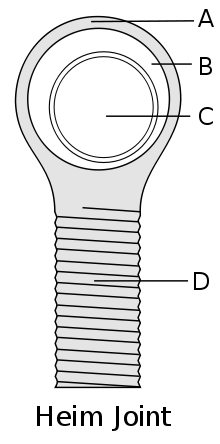Rod end bearing

(A) the casing
(B) the ball swivel
(C) the opening for attaching hardware
(D) the threaded shaft
A rod end bearing, also known as a heim joint (N. America) or rose joint (U.K. and elsewhere), is a mechanical articulating joint. Such joints are used on the ends of control rods, steering links, tie rods, or anywhere a precision articulating joint is required, and where a clevis end (which requires perfect 90 degree alignment between the attached shaft and the second component) is unsuitable. A ball swivel with an opening through which a bolt or other attaching hardware may pass is pressed into a circular casing with a threaded shaft attached. The threaded portion may be either male or female. The heim joint's advantage is that the ball insert permits the rod or bolt passing through it to be misaligned to a limited degree (an angle other than 90 degrees). A link terminated in two heim joints permits misalignment of their attached shafts (viz., other than 180 degrees) when used in tension. When used in compression, the through-rods are forced to the extreme ends of their ball's misalignment range, which cocks the link at an oblique angle.
History
The spherical rod end bearing was developed by the Germans in World War II.[1] The H.G. Heim Company was given an exclusive patent to manufacture these joints in North America, while in the UK the patent passed to Rose Bearings Ltd.[2] The ubiquity of these manufacturers in their respective markets led to the terms heim joint and rose joint becoming synonymous with their product. After the patents ran out, the common names stuck although "rose joint" remains a registered trademark of Rose Bearings Ltd. Originally used in aircraft, the rod end bearing may be found in cars, trucks, race cars, motorcycles, lawn tractors, boats, industrial machines, go-karts, radio-control helicopters, and many more applications.
See also
References
- ↑ History of the Heim Joint - AKA Rod End Bearing
- ↑ Howard, K. 1999. Technofile: The rod end bearing. Motor Sport. LXXV/8 (August 1999), 70-71